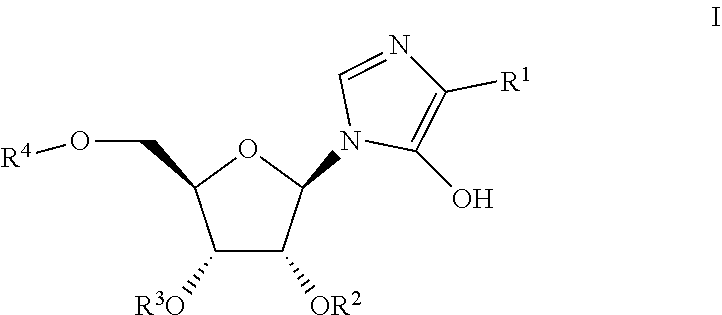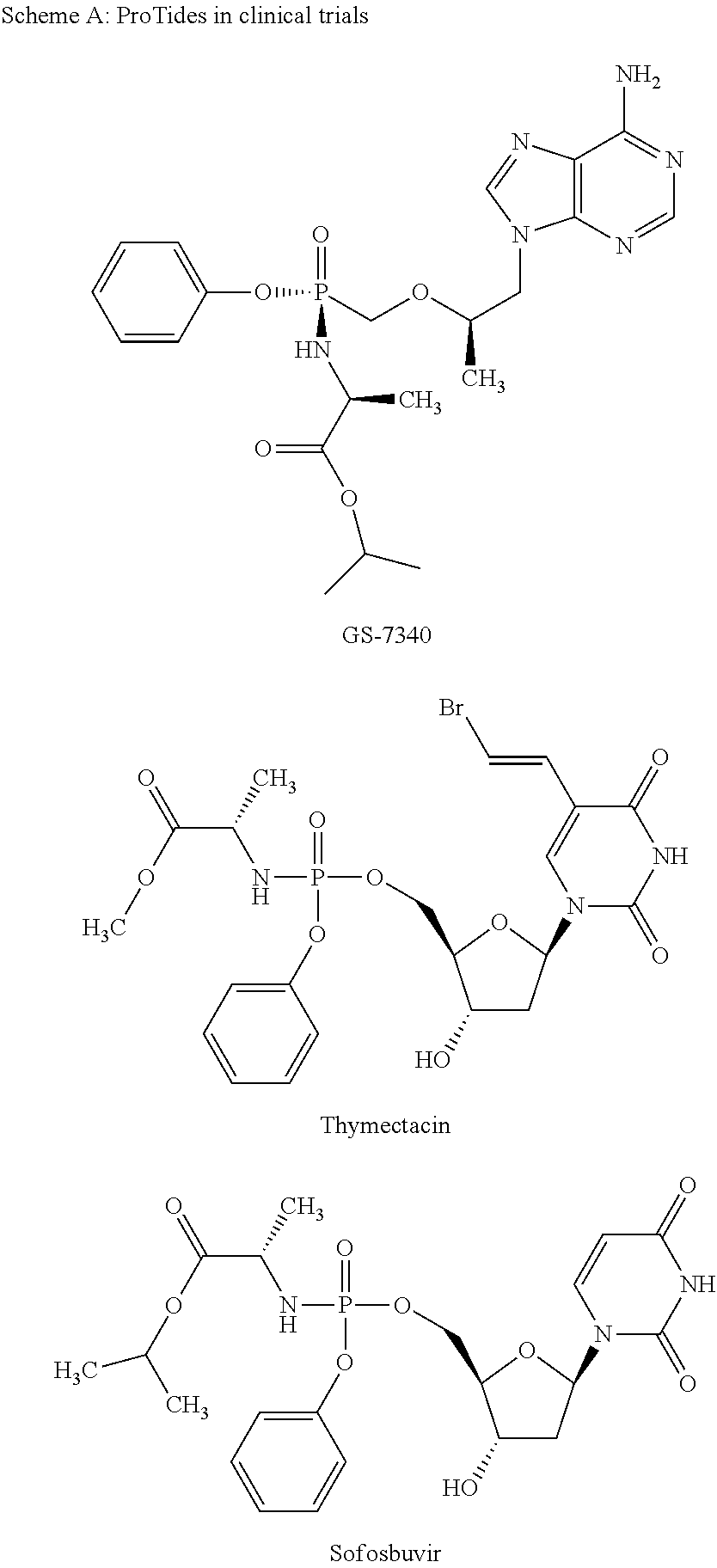Novel prodrugs of mizoribine
a technology of mizoribine and prodrug, applied in the field of new prodrug of mizoribine, can solve the problems of first and rate-limiting step in guanine nucleotide biosynthesis, inability to salvage pathway, and high resistance to impdh inhibition
- Summary
- Abstract
- Description
- Claims
- Application Information
AI Technical Summary
Benefits of technology
Problems solved by technology
Method used
Image
Examples
example 1
of the Di-isopropyl Ester of L-aspartic Acid (Compound 2a)
[0275]To a suspension of L-aspartic acid 1 (2.66 g, 20.0 mmol) in anhydrous isopropanol (100 mL) was added thionyl chloride (10 mL, 139 mmol) dropwise at 0° C. under argon atmosphere. The mixture was allowed to warm to room temperature and then refluxed for 8 hours. After evaporation, the solid residue was triturated with diethyl ether. The white solid product was then filtered and washed with diethyl ether to obtain the di-isopropyl ester of L-aspartic acid as hydrochloride salt (91%).
[0276]1H NMR (300 MHz, DMSO-d6): δ=8.75 (br s, 3H, —NH3+), 4.95 (m, 2H, —CH(CH3)2), 4.24 (m, 1H, a-H), 2.96 (m, 2H, P—H), 1.21 (m, 12H, —CH3) ppm.
example 2
of the Di-amyl Ester of L-aspartic Acid (compound 2b)
[0277]To a suspension of L-aspartic acid 1 (2.66 g, 20.0 mmol) in anhydrous amyl alcohol (100 mL) was added thionyl chloride (10 mL, 139 mmol) dropwise at 0° C. under argon atmosphere. The mixture was allowed to warm to room temperature and stirred for 12 h. The suspension was then refluxed for 4 h. After evaporation, the solid residue was triturated with diethyl ether (100 ml). The white solid product was then filtered and washed several times with diethyl ether to obtain the title compound as hydrochloride salt (84%).
[0278]1H NMR (300 MHz, DMSO-d6): δ=8.75 (br s, 3H, —NH3+), 4.22 (t, 1H, α-H), 4.06 (m, 4H, CH2), 3.02 (m, 2H, β-H), 1.58 (m, 4H, CH2), 1.29 (m, 8H, CH2), 0.87 (m, 6H, CH3) ppm.
example 3
of the Di-isoamyl Ester of L-aspartic Acid (Compound 2c)
[0279]To a suspension of L-aspartic acid (2.66 g, 20.0 mmol) in anhydrous iso-amyl alcohol (100 mL) was added thionyl chloride (10 mL, 139 mmol) dropwise at 0° C. under argon atmosphere. The mixture was allowed to warm to room temperature and stirred for an additional 12 h. The suspension was then refluxed for 4 h. After evaporation, the sticky residue was triturated with heptanes (100 ml). The white solid was then filtered and washed several times with heptane to yield the title compound as a hydrochloride salt (75%).
[0280]1H NMR (300 MHz, DMSO-d6): δ=8.73 (br s, 3H, —NH3+), 4.31 (t, 1H, α-H), 4.18 (m, 4H, CH2), 3.01 (m, 2H, β-H), 1.63 (m, 2H, CH), 1.48 (m, 4H, CH2), 0.90 (m, 12H, CH3) ppm.
B: Synthesis of Symmetric Di-esters of L-Glutamic Acid
[0281]
PUM
| Property | Measurement | Unit |
|---|---|---|
| Volume | aaaaa | aaaaa |
| Volume | aaaaa | aaaaa |
| Volume | aaaaa | aaaaa |
Abstract
Description
Claims
Application Information
 Login to View More
Login to View More - R&D
- Intellectual Property
- Life Sciences
- Materials
- Tech Scout
- Unparalleled Data Quality
- Higher Quality Content
- 60% Fewer Hallucinations
Browse by: Latest US Patents, China's latest patents, Technical Efficacy Thesaurus, Application Domain, Technology Topic, Popular Technical Reports.
© 2025 PatSnap. All rights reserved.Legal|Privacy policy|Modern Slavery Act Transparency Statement|Sitemap|About US| Contact US: help@patsnap.com



